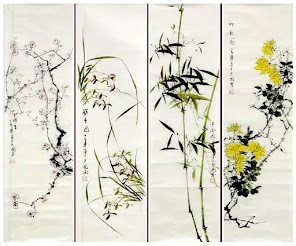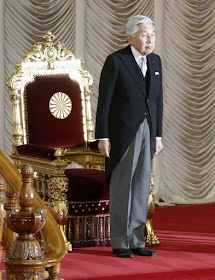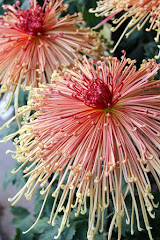exquisite or meaningful bloom associated with their month. The chrysanthemum comes in hundreds of varieties and each one is competing with the others to be the most beautiful bloom (see some stunning pictures here and here.) Unlike most other flowers, mums bloom in the chilly weather of autumn. This late-season blooming habit makes them the most obvious and popular choice for holiday bouquets, but for many people it has also made mums a symbol of vitality and perseverance. Mums have inspired symbolism across time and place. In Victorian times, they were symbols of well-wishing and friendship, in Australia they are the flowers of Mother’s Day (because they’re called “mums”, get it?), and in many European countries they have come to be symbols of death (which comes from their being used so frequently in funerals and graveyards). The meanings of chrysanthemums seem to be as wide-ranging as their varieties.
 In China the mum is venerated as a whole –their symbolism, their beauty, their medicinal qualities, their spiritual potential, and even their flavor. To underscore this devotion, look no further than this ancient Chinese saying: “If you would be happy for a lifetime, grow chrysanthemums”. As far back as 3,000 years ago Chinese people have been planting, painting and writing about the Chrysanthemum. It is one of the Four Gentlemen of traditional Chinese art. These four plants are the plum blossom, orchid, bamboo and chrysanthemum. They each represent a season (plum blossom-winter, orchid-spring, bamboo-summer and mums-autumn) and also embody the highest levels of integrity and moral character. Although these ideals/images became part of the culture in the time of Confucius (551-479 BCE), they have remained an element of Chinese thought even through communism. Chrysanthemums are now a part of Chinese identity, with towns being named after the flower (Chu Hsien=Chrysanthemum City) and weeks-long festivals held in its honor.
In China the mum is venerated as a whole –their symbolism, their beauty, their medicinal qualities, their spiritual potential, and even their flavor. To underscore this devotion, look no further than this ancient Chinese saying: “If you would be happy for a lifetime, grow chrysanthemums”. As far back as 3,000 years ago Chinese people have been planting, painting and writing about the Chrysanthemum. It is one of the Four Gentlemen of traditional Chinese art. These four plants are the plum blossom, orchid, bamboo and chrysanthemum. They each represent a season (plum blossom-winter, orchid-spring, bamboo-summer and mums-autumn) and also embody the highest levels of integrity and moral character. Although these ideals/images became part of the culture in the time of Confucius (551-479 BCE), they have remained an element of Chinese thought even through communism. Chrysanthemums are now a part of Chinese identity, with towns being named after the flower (Chu Hsien=Chrysanthemum City) and weeks-long festivals held in its honor.
The chrysanthemum came to Japan much later than China (5th century AD) and has since become deeply ingrained in Japanese culture. It had been widely admired and used in many facets of Japanese life for centuries before Emperor Go-Toba made it the official symbol of his reign (1183-1198). From that time to this day, the emperors of Japan have sat on the Chrysanthemum Throne. This concept encompasses not only the monarch, but the government that he rules. Thus, the image of this mum appears not just on the actual throne, but on official documents, stamps, coins and even Japanese passports. An interesting side note: Even though the role is mostly symbolic these days, the Japanese emperor represents the world’s oldest continuing hereditary monarchy; the same family has ruled for 2,600 years.
Although their beauty is undeniable, mums have more to offer than just good looks. They are the source of the powerful botanical pesticide Pyrethrin. Like the ancient Chinese, the ancient Persians had mums, and they all were well aware of its insecticidal properties. As early as 400 BC, Persians were rubbing pyrethrin ointments on their livestock to repel fleas and ticks. This article suggests that the mum, and it’s use as an insecticide, originated in Persia (modern-day Iran) and was brought to China along the Silk Road 2,000 years ago. Others claim it moved the opposite way. Wherever and however this use began, it remains an excellent alternative to synthetic pesticides. We carry a number of top-notch pyrethrin products – check them out here.
The introduction of pyrethrin was likely a game changer for those ancient Chinese and Persians, and the same can be said for people in Kenya when British colonizers brought it there in the late 1920s. Since pyrethrin has been around so long, it's unlikely that Kenyans had never heard of it, but the British presented it as a money-making crop and that was the game changing part. It seems Kenya has the perfect climate for the daisy-like Chrysanthemum cinerariifolium that pyrethrin is derived from. These flowers grow prolifically after the semi-annual rains and they can be harvested as frequently as every two weeks, providing a nearly year-round income for growers. By the 1940s, Kenya had replaced Japan as the world’s number on producer (a position it had held for hundreds of years. In addition to the financial benefits that this flower brought to local farmers, it turns
out that just growing the plant is enough to
repel the sand flies that carry leishmaniasis. This infection, which can cause painful skin lesions and attack internal organs, has maimed or killed untold numbers of people in Africa. The benefits that the chrysanthemum brought to the Kenyan people got lost for a while as they struggled with their new-found independence in the 1960s, but it was still cherished enough to be a part of the new Kenyan Coat of Arms. Nowadays, the mum is back to being widely produced by farmers in Kenya and studies are being done to determine how it can be used to control the locust hordes that regularly decimate crops in Africa.
It’s hard to think of any other flower that has such widespread devotion, with the possible exception of the rose. Chrysanthemums are undoubtedly gorgeous, in all their varieties, but they also make a healthful and delicious tea that is a natural de-stressor. If you want to take a moment to try some Chrysanthemum Tea, here’s a video from a tea expert.














No comments:
Post a Comment